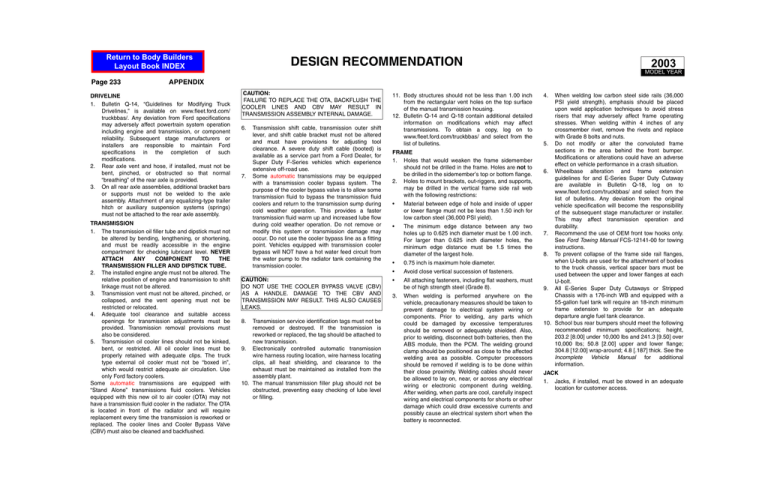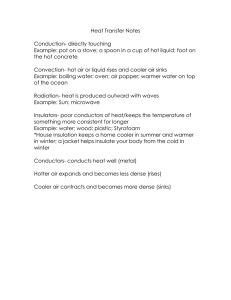Driveline / Transmission / Frame / Jack
advertisement

Return to Body Builders Layout Book INDEX Page 233 DESIGN RECOMMENDATION 2003 MODEL YEAR APPENDIX DRIVELINE 1. Bulletin Q-14, “Guidelines for Modifying Truck Drivelines,” is available on www.fleet.ford.com/ truckbbas/. Any deviation from Ford specifications may adversely affect powertrain system operation including engine and transmission, or component reliability. Subsequent stage manufacturers or installers are responsible to maintain Ford specifications in the completion of such modifications. 2. Rear axle vent and hose, if installed, must not be bent, pinched, or obstructed so that normal “breathing” of the rear axle is provided. 3. On all rear axle assemblies, additional bracket bars or supports must not be welded to the axle assembly. Attachment of any equalizing-type trailer hitch or auxiliary suspension systems (springs) must not be attached to the rear axle assembly. TRANSMISSION 1. The transmission oil filler tube and dipstick must not be altered by bending, lengthening, or shortening, and must be readily accessible in the engine compartment for checking lubricant level. NEVER ATTACH ANY COMPONENT TO THE TRANSMISSION FILLER AND DIPSTICK TUBE. 2. The installed engine angle must not be altered. The relative position of engine and transmission to shift linkage must not be altered. 3. Transmission vent must not be altered, pinched, or collapsed, and the vent opening must not be restricted or relocated. 4. Adequate tool clearance and suitable access openings for transmission adjustments must be provided. Transmission removal provisions must also be considered. 5. Transmission oil cooler lines should not be kinked, bent, or restricted. All oil cooler lines must be properly retained with adequate clips. The truck type external oil cooler must not be “boxed in”, which would restrict adequate air circulation. Use only Ford factory coolers. Some automatic transmissions are equipped with “Stand Alone” transmissions fluid coolers. Vehicles equipped with this new oil to air cooler (OTA) may not have a transmission fluid cooler in the radiator. The OTA is located in front of the radiator and will require replacement every time the transmission is reworked or replaced. The cooler lines and Cooler Bypass Valve (CBV) must also be cleaned and backflushed. CAUTION: FAILURE TO REPLACE THE OTA, BACKFLUSH THE COOLER LINES AND CBV MAY RESULT IN TRANSMISSION ASSEMBLY INTERNAL DAMAGE. 6. 7. Transmission shift cable, transmission outer shift lever, and shift cable bracket must not be altered and must have provisions for adjusting tool clearance. A severe duty shift cable (booted) is available as a service part from a Ford Dealer, for Super Duty F-Series vehicles which experience extensive off-road use. Some automatic transmissions may be equipped with a transmission cooler bypass system. The purpose of the cooler bypass valve is to allow some transmission fluid to bypass the transmission fluid coolers and return to the transmission sump during cold weather operation. This provides a faster transmission fluid warm up and increased lube flow during cold weather operation. Do not remove or modify this system or transmission damage may occur. Do not use the cooler bypass line as a fitting point. Vehicles equipped with transmission cooler bypass will NOT have a hot water feed circuit from the water pump to the radiator tank containing the transmission cooler. CAUTION: DO NOT USE THE COOLER BYPASS VALVE (CBV) AS A HANDLE. DAMAGE TO THE CBV AND TRANSMISSION MAY RESULT. THIS ALSO CAUSES LEAKS. 8. Transmission service identification tags must not be removed or destroyed. If the transmission is reworked or replaced, the tag should be attached to new transmission. 9. Electronically controlled automatic transmission wire harness routing location, wire harness locating clips, all heat shielding, and clearance to the exhaust must be maintained as installed from the assembly plant. 10. The manual transmission filler plug should not be obstructed, preventing easy checking of lube level or filling. 11. Body structures should not be less than 1.00 inch from the rectangular vent holes on the top surface of the manual transmission housing. 12. Bulletin Q-14 and Q-18 contain additional detailed information on modifications which may affect transmissions. To obtain a copy, log on to www.fleet.ford.com/truckbbas/ and select from the list of bulletins. FRAME 1. Holes that would weaken the frame sidemember should not be drilled in the frame. Holes are not to be drilled in the sidemember’s top or bottom flange. 2. Holes to mount brackets, out-riggers, and supports, may be drilled in the vertical frame side rail web with the following restrictions: • Material between edge of hole and inside of upper or lower flange must not be less than 1.50 inch for low carbon steel (36,000 PSI yield). • The minimum edge distance between any two holes up to 0.625 inch diameter must be 1.00 inch. For larger than 0.625 inch diameter holes, the minimum edge distance must be 1.5 times the diameter of the largest hole. • 0.75 inch is maximum hole diameter. • Avoid close vertical succession of fasteners. • All attaching fasteners, including flat washers, must be of high strength steel (Grade 8). 3. When welding is performed anywhere on the vehicle, precautionary measures should be taken to prevent damage to electrical system wiring or components. Prior to welding, any parts which could be damaged by excessive temperatures should be removed or adequately shielded. Also, prior to welding, disconnect both batteries, then the ABS module, then the PCM. The welding ground clamp should be positioned as close to the affected welding area as possible. Computer processors should be removed if welding is to be done within their close proximity. Welding cables should never be allowed to lay on, near, or across any electrical wiring or electronic component during welding. After welding, when parts are cool, carefully inspect wiring and electrical components for shorts or other damage which could draw excessive currents and possibly cause an electrical system short when the battery is reconnected. 4. When welding low carbon steel side rails (36,000 PSI yield strength), emphasis should be placed upon weld application techniques to avoid stress risers that may adversely affect frame operating stresses. When welding within 4 inches of any crossmember rivet, remove the rivets and replace with Grade 8 bolts and nuts. 5. Do not modify or alter the convoluted frame sections in the area behind the front bumper. Modifications or alterations could have an adverse effect on vehicle performance in a crash situation. 6. Wheelbase alteration and frame extension guidelines for and E-Series Super Duty Cutaway are available in Bulletin Q-18, log on to www.fleet.ford.com/truckbbas/ and select from the list of bulletins. Any deviation from the original vehicle specification will become the responsibility of the subsequent stage manufacturer or installer. This may affect transmission operation and durability. 7. Recommend the use of OEM front tow hooks only. See Ford Towing Manual FCS-12141-00 for towing instructions. 8. To prevent collapse of the frame side rail flanges, when U-bolts are used for the attachment of bodies to the truck chassis, vertical spacer bars must be used between the upper and lower flanges at each U-bolt. 9. All E-Series Super Duty Cutaways or Stripped Chassis with a 176-inch WB and equipped with a 55-gallon fuel tank will require an 18-inch minimum frame extension to provide for an adequate departure angle fuel tank clearance. 10. School bus rear bumpers should meet the following recommended minimum specifications; height, 203.2 [8.00] under 10,000 lbs and 241.3 [9.50] over 10,000 lbs; 50.8 [2.00] upper and lower flange; 304.8 [12.00] wrap-around; 4.8 [.187] thick. See the Incomplete Vehicle Manual for additional information. JACK 1. Jacks, if installed, must be stowed in an adequate location for customer access.




